Turn off messaging or calling for Webex App users
 Feedback?
Feedback?About messaging and calling feature licenses
We entitle all customers to use basic messaging and calling features in Webex, at no cost. In a single app, users get a consistent experience with quick access to everything essential (documents, discussions, voicemails, meeting invitations, recordings, and more). The app provides continuity in conversations without needing to switch apps, increasing productivity.
While we recommend that our customers use the full Webex App, we understand that you might need to turn off certain functionality to roll out Webex slowly across the org, if you're using a different app for those functions, or for compliance reasons.
As an administrator with User Management access, you can turn off the following features by removing licenses:
-
Basic Messaging (also disables Basic Space Meetings)
-
Basic Calling
-
Basic Messaging and Basic Calling (also disables Basic Space Meetings)
You can remove these licenses using any of the available methods to assign or modify licenses in Control Hub, or by using the APIs.
Before you make broad changes to your Webex organization licensing, we recommend the following preparation steps.
| 1 |
Consult with your fellow admins to determine the licenses you want to award to each user profile in Control Hub. Consider a license planning session to profile your users and grant licenses accordingly. |
| 2 |
Validate license assignment with a handful of users before applying larger scale changes. |
| 3 |
Set up a feedback channel in your organization for you to be able to collect feedback. |
If you do not use automatic license assignment, but you want to disable basic messaging or calling, we recommend that you use automatic license assignments. You can have a template for your whole organization, or for each group that you synchronize from Active Directory.
Use this procedure to set the automatic assignment to turn off the basic licenses for users as they join. Otherwise, new users will get the basic messaging license and the basic calling license (because they are on by default) and you will need to turn off the licenses you don't want for each user as they join.
If you are planning on synchronizing users from an external directory such as Active Directory or Okta, set up the template before synchronizing. If you're already synchronizing users with a directory, you should do both these steps and the steps in Remove Basic Messaging or Calling from existing users.
| 1 |
Sign in to your organization at https://admin.webex.com, and open the Users page. |
| 2 |
Click . |
| 3 |
To disable messaging, clear the Basic Messaging box. If you have any Advanced Messaging licenses, and you want to disable all messaging, clear that box. |
| 4 |
To disable calling, go to the Calling tab and then clear the Call on Webex box. |
| 5 |
Click Save |
| 6 |
Repeat this for all other groups if you are using group-based license assignment templates. |
What to do next
The license template change does not affect existing users in your organization. Do these steps to remove basic messaging or calling from those users.
- Advanced and Basic Space Meetings licenses require a Basic Messaging license. In order to remove Basic Messaging, you must also remove both Advanced and Basic Space Meetings licenses. Otherwise, the CSV will have errors.
- You have to assign a Basic Messaging license with the Advanced Messaging license. Advanced Messaging can't be assigned without Basic Messaging.
Before you begin
Be careful when removing features that are in use. For example, if you accidentally disable messaging, users lose access to all spaces and messages. The data is retained on the server in line with your organization's retention policies, so you can restore access immediately if you need to.
| 1 |
On the Users page, click Manage Users. |
| 2 |
Click CSV add or edit. |
| 3 |
Click Export, and open the downloaded CSV file. We recommend downloading a new CSV file when making changes to user licenses—particularly when removing licenses—rather than using a file that you’ve downloaded in the past. |
| 4 |
To disable messaging, change all cells in the following columns to
If you have any |
| 5 |
To disable calling, find the |
| 6 |
Save the modified CSV file. |
| 7 |
On the Users page, click Manage Users then CSV Add or Modify Users. |
| 8 |
Click through the warning about users receiving email, then drag the modifed CSV file and drop it onto the import area. |
| 9 |
Select Add and remove services and click Next. |
| 10 |
Wait for the process to complete, review any errors, then Close the wizard. |
Messaging off
With Basic Messaging disabled, app users can't send or receive chat messages. The Messaging and Teams
and Teams controls are not on the navigation menu.
controls are not on the navigation menu.
Users still have their calling and meeting controls if they are appropriately licensed.
|
Feature |
Available if Basic Messaging disabled? |
|---|---|
|
Message someone directly (1:1) |
— |
|
Message in a group space |
— |
|
Share desktop outside of a call or meeting |
— |
|
Share desktop in a call or meeting |
Yes |
|
Schedule a meeting in a space |
— |
|
Call someone's Webex App directly (1:1) |
Yes |
|
Use Calling and Voicemail navigation menu items |
Yes |
|
Use Join button (One Button to Push) for meetings on a Webex meeting site |
Yes |
|
Schedule a meeting on a Webex meeting site |
Yes, with host license. |
|
Use the whiteboard |
— |
|
Annotate |
Yes, during desktop share in an active call. No. When there is no active call, the user cannot share desktop or annotate. |
|
See presence info for a user |
Yes |
The Webex App prevents you from creating spaces with users who do not have messaging. This could happen if some users in your organization have messaging and you have removed the licenses from others.
What this looks like to users without messaging
Users can schedule, join, and start meetings from the calendar view. They do not have spaces, so they cannot schedule meetings in spaces.
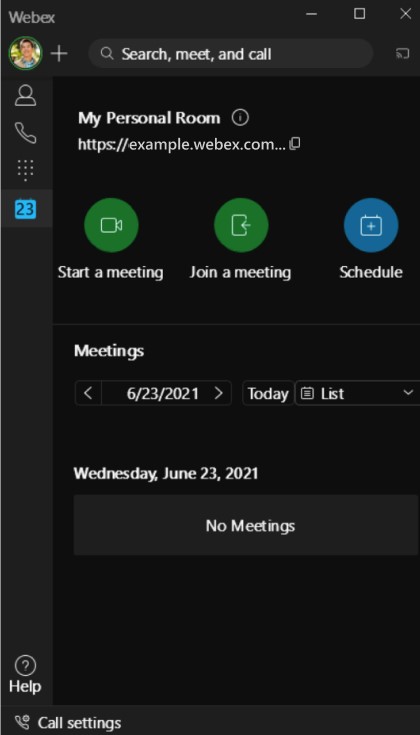
Users can make and receive calls, so they still see their contacts, keypad, and call history:
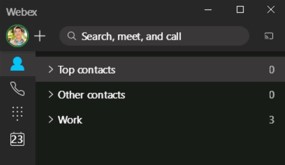
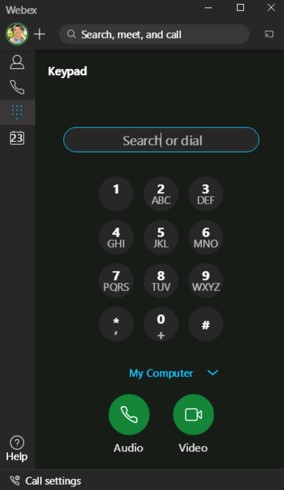
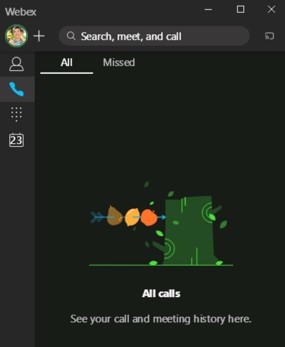
What this looks like to your users who can use messaging features
If you have users within your organization who have messaging licenses, they can't use their messaging controls to collaborate with users who do not have the license. They can see the controls, but they are inactive.
You can't invite those users to spaces; their names are grayed out, and their status says they can't receive messages:
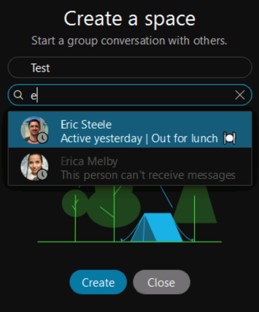
You can't send a direct message to those users, their names are grayed out when you search for them:

You can't use the direct message control on a user's contact card. The control is visible but inactive, and there's an alert reminding you that the person can't receive messages. The other collaboration modes are still active on the contact card:
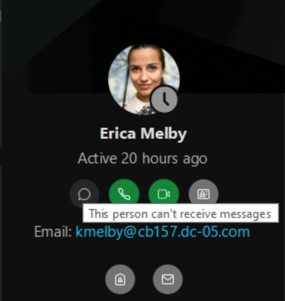
Your contacts view shows users who can't receive messages. The direct message control is visible but inactive, and the other collaboration modes are still active on the contact:
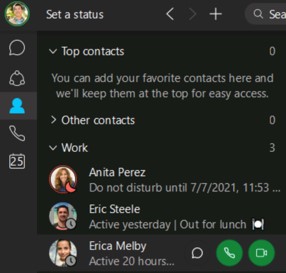
Call on Webex Off (and no other calling option)
When you disable the free Call on Webex license for a user, and there is no paid-for calling license in place, then the user cannot make calls from the Webex App.
|
Feature |
Available if Call on Webex disabled? |
|---|---|
|
Message someone directly (1:1) |
Yes |
|
Message in a group space |
Yes |
|
Share desktop outside of a call or meeting |
Yes |
|
Share desktop in a call or meeting |
— |
|
Schedule a meeting in a space |
Yes |
|
Call someone's Webex App directly (1:1) |
— |
|
Use Calling and Voicemail navigation menu items |
No Yes, with advanced calling license (calling option is something different to Call on Webex). |
|
Use Join button (One Button to Push) for meetings on a Webex meeting site |
Yes |
|
Schedule a meeting on a Webex meeting site |
Yes, with host license. |
|
Use the whiteboard |
— |
|
Annotate |
— |
|
See presence info for a user |
Yes |
These users can use direct messaging, spaces, and teams, but the call history and keypad options are not available on the navigation menu:

Users can schedule, join, and start meetings from the calendar view:
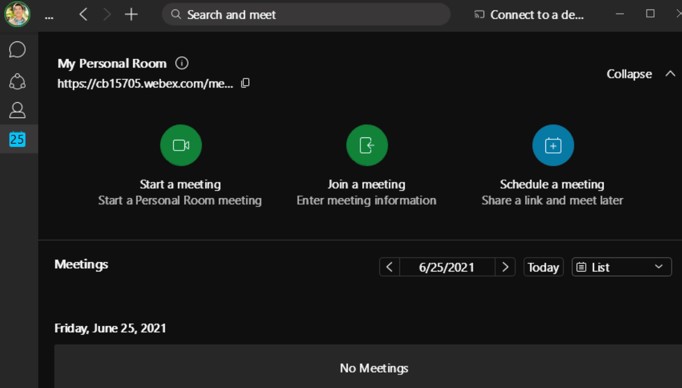
Both Messaging and Call on Webex Off (with a paid calling option)
With both Basic Messaging and Call on Webex disabled, users see the controls related to Meetings and their paid calling option. They can't use Call on Webex to call another user. Messaging  and Teams
and Teams  don't appear in the navigation menu.
don't appear in the navigation menu.
|
Feature |
Available if Basic Messaging and Call on Webex disabled? |
|---|---|
|
Message someone directly (1:1) |
— |
|
Message in a group space |
— |
|
Share desktop outside of a call or meeting |
— |
|
Share desktop in a call or meeting |
— |
|
Schedule a meeting in a space |
— |
|
Call someone's Webex app directly (1:1) |
— |
|
Use Calling and Voicemail navigation menu items |
Yes |
|
Use Join button (One Button to Push) for meetings on a Webex meeting site |
Yes |
|
Schedule a meeting on a Webex meeting site |
Yes, with host license. |
|
Use the whiteboard |
— |
|
Annotate |
— |
|
See presence info for a user |
Yes |
What Webex looks like to users who have a paid calling option without Basic Messaging
Users can schedule, join, and start meetings from the calendar view. They do not have spaces, so they cannot schedule meetings in spaces.

Users can make and receive calls, so they still see their contacts, keypad, and call history:

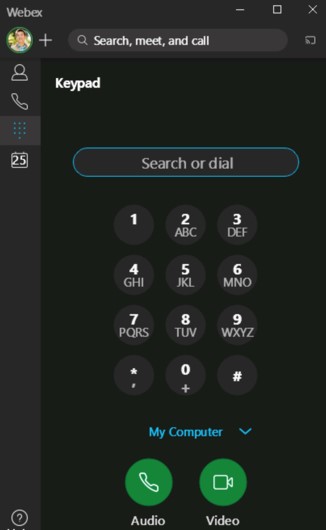
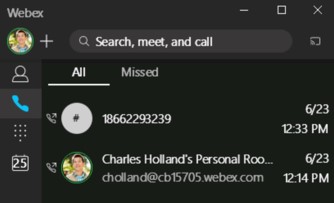
Basic Messaging off and Call on Webex off (Meetings only)
With both Basic Messaging and Call on Webex disabled, app users see only the navigation related to Meetings and (other) calling options. Webex App users can't use Call on Webex to call another user. Messaging and Teams
and Teams don't appear in the navigation menu.
don't appear in the navigation menu.
|
Feature |
Available if Basic Messaging and Call on Webex disabled? |
|---|---|
|
Message someone directly (1:1) |
— |
|
Message in a group space |
— |
|
Share desktop outside of a call or meeting |
— |
|
Share desktop in a call or meeting |
— |
|
Schedule a meeting in a space |
— |
|
Call someone's Webex app directly (1:1) |
— |
|
Use Calling and Voicemail navigation menu items |
Yes, with advanced calling license (calling option is something different to Call on Webex). |
|
Use Join button (One Button to Push) for meetings on a Webex meeting site |
Yes |
|
Schedule a meeting on a Webex meeting site |
Yes, with host license. |
|
Use the whiteboard |
— |
|
Annotate |
— |
|
See presence info for a user |
Yes |
What Webex looks like to users with no calling and no messaging
Users can schedule, join, and start meetings from the calendar view. The navigation menu does not have Teams, Messaging, Call history, or Keypad icons.
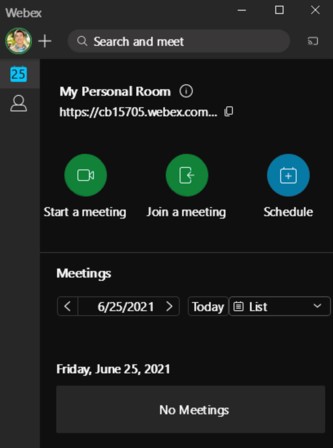
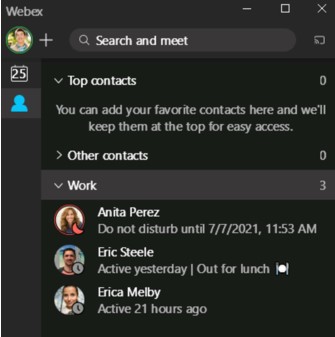
The user is not licensed to send direct messages, create spaces, or make calls. When they click the + button, they only see the options to add a contact or schedule a meeting:

When another user opens the contact card for a user who does not have messaging or calling licenses, they do not see the buttons that they would need to send a direct message or make a call to that user:

If I remove a user's messaging license, what happens to the user's messaging instance and data?
The user loses messaging capabilities, and can't send or receive messages.
The user's data (messages, files, and so on) is retained according to your organization's retention policy.
How long will the changes take to appear on the Webex App?
The license changes can take up to 24 hours to reflect in the application.
Will you send out a welcome email when I modify licenses for a user?
We only send welcome emails to users once, when you first onboard them. They won't receive an email for license modification. If you plan to modify user licenses, you should plan to communicate with the users as well.
How can I stop these welcome emails from being sent out?
What if I remove a license by mistake? Does that person lose all their messages?
We retain user-generated data for a period of time, so you may be able to get the user's data back by granting the license again. The message retention period is governed by your organization's retention policy.
Can I modify licenses via the API?
Yes. See the API documentation at https://developer.webex.com/docs/admin-api-guide.
- Advanced and Basic Space Meetings licenses require a Basic Messaging license. In order to remove Basic Messaging, you must also remove both Advanced and Basic Space Meetings licenses. Otherwise, the APIs will have errors.
- You have to assign a Basic Messaging license with the Advanced Messaging license. Advanced Messaging can't be assigned without Basic Messaging.
Relevant API calls:
-
Create user:
POST v1/peopleUpdate user:
PUT v1/people/{personID}View user list:
GET v1/people
To remove one or more licenses from a user, update the user with every license except the ones to be removed, from the following list of BASE64 encoded strings (replacing ORGID and USERID with the appropriate values):
| License |
String |
|---|---|
|
UCM License |
ciscospark://us/LICENSE/ORGID:UCPREM_USERID
|
|
Basic Messaging |
ciscospark://us/LICENSE/ORGID:FMS_USERID
|
|
Basic Space Meetings Basic space meetings are automatically assigned when you have a messaging license (basic or advanced). You cannot control them individually. |
ciscospark://us/LICENSE/ORGID:FTM_USERID
|
|
Basic Calling |
ciscospark://us/LICENSE/ORGID:FTC_USERID
|
General issues with removing licenses
-
Changes to user licensing can take up to 24 hours to propagate through the system.
Issues with removing Basic Messaging license
-
If a user in a different organization sends a message to a user who does not have Basic Messaging, Webex does not tell the sender that the message was not delivered.
This issue exists because we do not share messaging capabilities between organizations.
-
If two users within the same organization share a 1:1 messaging space, and then one of those users has Basic Messaging removed, the other user can still send messages to the space.


